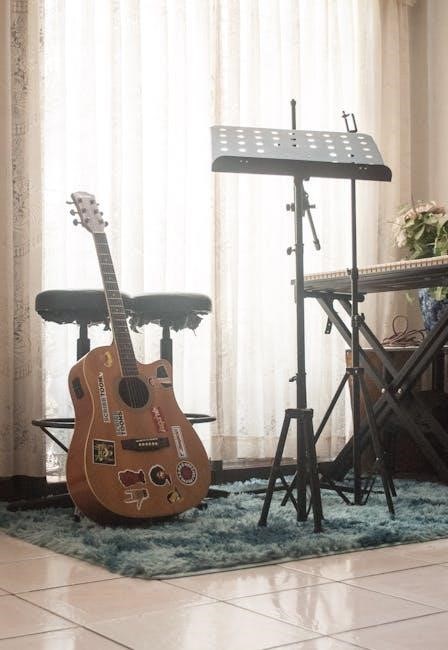bohemian rhapsody sheet music pdf piano
Bohemian Rhapsody‚ Queen’s iconic 1975 song‚ is a six-part rock ballad blending opera‚ hard rock‚ and classical music. Its complex composition and emotional depth captivate pianists worldwide‚ inspiring countless adaptations and interpretations. The song’s enduring popularity‚ amplified by the 2018 biopic‚ has made its sheet music highly sought after for piano enthusiasts seeking to master its intricate arrangement and rich musical layers.
1.1 Overview of the Song
Bohemian Rhapsody‚ released in 1975‚ is Queen’s groundbreaking six-part rock ballad; It seamlessly blends opera‚ hard rock‚ and classical music‚ creating a unique musical experience. The song’s complexity‚ with its dramatic vocals‚ intricate harmonies‚ and shifting genres‚ has made it a timeless classic. Its enduring popularity has led to numerous adaptations‚ including piano arrangements‚ allowing pianists to explore its rich layers. The song’s sheet music is highly sought after‚ offering both simplified versions for beginners and advanced arrangements for skilled pianists‚ making it a versatile piece for musical exploration and performance.
1.2 Historical Context and Significance
Bohemian Rhapsody‚ released in 1975‚ marked a pivotal moment in rock music history. Its innovative blend of opera‚ rock‚ and classical genres defied conventional song structures‚ setting a new standard for musical creativity. The song’s complexity and emotional depth resonated globally‚ making it an instant classic. Its success challenged traditional radio formats‚ proving that lengthy‚ unconventional tracks could achieve mainstream success. Today‚ its enduring popularity is evident in its sheet music demand‚ particularly for piano arrangements‚ allowing pianists to explore its intricate layers and pay homage to Freddie Mercury’s visionary composition.
1.3 Why “Bohemian Rhapsody” is a Unique Composition
Bohemian Rhapsody stands out as a groundbreaking composition due to its unconventional structure and genre fusion. The song seamlessly blends opera‚ rock‚ and classical music‚ creating a six-part epic that defies traditional songwriting norms. Its lack of a repetitive verse-chorus structure‚ combined with its dramatic vocal and instrumental shifts‚ makes it a rarity in rock music. Freddie Mercury’s visionary creativity‚ showcased through his vocal range and piano work‚ further elevates its uniqueness. The song’s length and complexity were initially risky‚ but they ultimately became its defining strengths‚ solidifying its status as a timeless masterpiece and a benchmark for musical innovation.

The Structure of “Bohemian Rhapsody”
Bohemian Rhapsody’s structure is unconventional‚ blending ballad‚ opera‚ and hard rock. Its six distinct sections‚ including a cappella and instrumental solos‚ showcase Queen’s innovative composition‚ challenging pianists with its complexity and genre fusion while remaining a timeless masterpiece.
2.1 Musical Sections and Genres
Bohemian Rhapsody is structured into six distinct sections: intro‚ ballad‚ opera‚ hard rock‚ outro‚ and a cappella. The song blends genres like progressive rock‚ classical‚ and opera‚ creating a unique sound. The intro features a piano ballad‚ transitioning into operatic vocals‚ followed by a face-melting guitar solo in the hard rock section. This unconventional mix of styles defies traditional songwriting‚ showcasing Queen’s creativity. The operatic section includes complex harmonies and layered vocals‚ while the hard rock part emphasizes powerful instrumentation. This diversity in genres and sections makes the song a standout piece in rock history‚ challenging pianists to master its intricate transitions and dynamic range.
2.2 Lyric Analysis and Interpretation
Bohemian Rhapsody’s lyrics are a poetic blend of storytelling and emotional introspection‚ exploring themes of life‚ death‚ and redemption. The song’s narrative follows a young man confessing to murder‚ grappling with fate‚ and seeking forgiveness. Freddie Mercury’s cryptic words leave room for interpretation‚ with some linking the lyrics to his personal struggles and identity. The operatic sections add dramatic tension‚ while the ballad portions convey vulnerability. The song’s abstract nature has sparked countless theories‚ making it a timeless puzzle for fans and scholars alike. Its depth and complexity continue to inspire pianists to capture its emotional essence through sheet music adaptations.
2.3 Instrumental Arrangement and Complexity
Bohemian Rhapsody’s instrumental arrangement is renowned for its intricate complexity‚ blending operatic grandeur‚ hard rock intensity‚ and delicate balladry. The song features layered vocal harmonies‚ a sprawling operatic section‚ and a powerful guitar solo‚ all of which present unique challenges for pianists. The piano sheet music must capture the dynamic shifts‚ from the soft‚ melancholic intro to the dramatic‚ operatic crescendos. Mercury’s vocal range and the band’s orchestral approach demand a nuanced piano adaptation‚ balancing complexity with playability. The arrangement’s depth and versatility make it a captivating yet demanding piece for pianists to master.

Sheet Music for Piano
Discover official Bohemian Rhapsody sheet music for piano‚ available on Queen’s website and licensed platforms. Both free and paid versions cater to pianists of all skill levels‚ ensuring authenticity and playability.
3.1 Where to Find “Bohemian Rhapsody” Sheet Music
Piano enthusiasts can find Bohemian Rhapsody sheet music on Queen’s official website‚ musicnotes.com‚ and other licensed platforms. These sources offer authentic arrangements‚ ensuring fidelity to the original composition. Additionally‚ websites like Piano Nanny and MyPianoNotes provide free and paid versions‚ catering to pianists of all skill levels. For those seeking high-quality PDFs‚ platforms like Sheet Music Plus and Musicnotes deliver professionally transcribed scores. Always verify the source’s legitimacy to ensure you’re accessing accurate and legally distributed sheet music. This variety of options makes it easy for pianists to find the perfect arrangement to suit their playing style and skill level.
3.2 Official Queen Website and Licensed Sources
The official Queen website is the primary source for authentic Bohemian Rhapsody sheet music‚ offering high-quality‚ legally licensed arrangements. Reputable platforms like Musicnotes‚ Sheet Music Plus‚ and Piano Nanny also provide verified sheet music‚ ensuring accuracy and quality. These sources are endorsed by Queen‚ guaranteeing that the music is faithfully transcribed. For pianists seeking the most authentic experience‚ purchasing from these licensed sources supports the artists and provides access to professional-grade scores. Always verify the legitimacy of the source to avoid unauthorized versions and ensure a premium musical experience.
3.3 Free vs. Paid Sheet Music Options
For pianists seeking Bohemian Rhapsody sheet music‚ free and paid options are available. Free versions‚ often found on platforms like MuseScore or shared by enthusiasts‚ can be cost-effective but may lack quality or accuracy. Paid options from reputable sites like Musicnotes or Sheet Music Plus offer professionally transcribed scores‚ ensuring precision and detail. While free versions suffice for casual practice‚ paid sheet music provides superior arrangements‚ making it ideal for serious pianists. Always consider the source’s credibility to avoid poorly transcribed or unauthorized copies. Balancing budget and quality is key to mastering this iconic piece.

Playing “Bohemian Rhapsody” on the Piano
Playing Bohemian Rhapsody on the piano requires skill and dedication. Its intricate composition demands practice to capture the song’s emotional depth. Patience and persistence are key to mastering this iconic piece.
4.1 Simplified Versions for Beginners
For beginners‚ simplified versions of Bohemian Rhapsody sheet music are essential. These arrangements focus on the song’s core melodies and chords‚ making it accessible to those with limited experience. By breaking down complex sections into easier-to-play parts‚ pianists can gradually build confidence. Many resources offer simplified scores that maintain the song’s essence while reducing technical demands. Starting with the ballad section or iconic chorus can provide a sense of accomplishment. These versions are a great starting point for mastering the song’s foundational elements before tackling its full complexity.
4.2 Intermediate and Advanced Arrangements
Intermediate and advanced pianists can explore intricate arrangements of Bohemian Rhapsody that capture its original complexity. These versions incorporate layered harmonies‚ dramatic tempo shifts‚ and the song’s operatic sections. Pianists can emphasize dynamic contrasts‚ arpeggios‚ and complex chord progressions to replicate the track’s grandeur. Advanced arrangements often feature virtuosic techniques‚ such as rapid arpeggios and intricate fingerwork‚ challenging even skilled musicians. Using tools like sustain pedals and nuanced articulation can enhance the performance. Practicing challenging sections at slower tempos and gradually increasing speed is recommended. These arrangements allow pianists to showcase their technical prowess and musical expression‚ making the song a rewarding challenge.
4.3 Tips for Mastering the Song
Mastering Bohemian Rhapsody on piano requires dedication and a structured approach. Start by breaking the song into manageable sections‚ focusing on complex passages like the operatic and rock segments. Practice arpeggios and chord progressions slowly‚ gradually increasing tempo. Use a metronome to maintain precise timing‚ especially during transitions. Emphasize dynamic contrasts to capture the song’s emotional depth. Pay attention to pedaling techniques to enhance resonance and expression. Record your performances to identify areas for improvement. Finally‚ study Freddie Mercury’s original piano parts and Queen’s recordings for inspiration. With consistent practice‚ you’ll conquer this iconic piece.

The Role of Freddie Mercury in Creating the Song
Freddie Mercury was the visionary behind Bohemian Rhapsody‚ blending opera‚ rock‚ and classical music. His unique vocal and piano contributions‚ along with his emotional depth‚ shaped the song’s complexity and enduring legacy.
5.1 Freddie Mercury’s Creative Process
Freddie Mercury’s creative process for Bohemian Rhapsody was visionary and meticulous. He began developing the song in the late 1960s‚ initially as scattered ideas on paper. Mercury often played fragments of the song during his time with Smile‚ showcasing his early experimentation. His unique ability to blend opera‚ rock‚ and classical music laid the foundation for the song’s complexity. Mercury’s process was deeply personal‚ with lyrics reflecting emotional struggles and introspection. He guided Queen through the recording‚ ensuring every section‚ from the operatic vocals to the hard rock riffs‚ was executed flawlessly. His innovative approach cemented Bohemian Rhapsody as a landmark in music history.
5.2 The Evolution of the Song Over Time
Bohemian Rhapsody evolved significantly from its inception in the late 1960s to its release in 1975. Initially‚ Freddie Mercury worked on fragments‚ experimenting with operatic and rock elements. The song’s structure expanded during Queen’s 1975 recording sessions‚ with intricate arrangements and layered vocals. Over time‚ live performances‚ such as the iconic 1985 Live Aid‚ further cemented its legacy. The 2018 biopic reignited global interest‚ introducing the song to new generations. This evolution highlights Mercury’s visionary creativity and the song’s enduring appeal‚ making it a timeless classic in rock music history.
5.3 Mercury’s Vocal and Piano Contributions
Freddie Mercury’s vocal and piano contributions to “Bohemian Rhapsody” were instrumental in shaping its iconic sound. His multi-octave vocal range allowed for dramatic shifts between soft ballad sections and powerful operatic crescendos. Mercury’s piano playing provided the emotional foundation‚ particularly in the song’s introspective opening and closing sections. His innovative use of layered vocal harmonies and complex arrangements showcased his genius as both a vocalist and pianist. The biopic further highlighted his creative process‚ emphasizing his integral role in crafting the song’s timeless appeal and musical depth.

The Impact of “Bohemian Rhapsody” on Music
Bohemian Rhapsody revolutionized rock with genre-blending style and operatic elements‚ setting a new standard for innovation‚ influencing artists‚ and remaining a timeless musical icon.
6.1 Influence on Rock Music
Bohemian Rhapsody’s innovative blend of opera‚ rock‚ and classical music redefined the boundaries of rock‚ inspiring countless artists to experiment with unconventional structures and genres. Its success without a traditional verse-chorus format encouraged creative freedom‚ making it a benchmark for rock innovation. The song’s theatricality and emotional depth raised the bar for live performances‚ while its production complexity influenced recording techniques. Its enduring popularity‚ amplified by the biopic‚ continues to inspire new generations of musicians‚ solidifying its legacy as a groundbreaking force in rock music history.
6.2 The Song’s Legacy and Popularity
Bohemian Rhapsody remains one of the most beloved and enduring songs in rock history‚ with over a billion streams and a timeless appeal that transcends generations. Its unique structure and emotional depth continue to captivate audiences‚ making it a staple in music culture. The 2018 biopic further boosted its popularity‚ introducing the song to new fans. Its influence is evident in countless covers and adaptations‚ while its original version retains its iconic status. The song’s legacy is celebrated through its ongoing impact on music and its ability to connect with listeners on a profound level‚ ensuring its lasting relevance.
6.3 Covers and Adaptations
Bohemian Rhapsody has inspired countless covers and adaptations‚ showcasing its timeless appeal. Artists like Elton John and Benson Boone have reimagined the song‚ blending their unique styles with its iconic structure. The track’s versatility has led to versions in genres ranging from classical to jazz‚ further cementing its cultural impact. Its adaptability has also made it a favorite in media‚ with appearances in films‚ TV shows‚ and live performances. These interpretations highlight the song’s enduring influence and its ability to resonate with diverse audiences‚ ensuring its legacy as a musical masterpiece continues to grow and evolve.

The “Bohemian Rhapsody” Film and Its Relation to the Song
The 2018 biopic‚ starring Rami Malek‚ revitalized interest in the song‚ showcasing its creation and emotional depth‚ further popularizing its sheet music among pianists worldwide.
7.1 The Biopic and Its Success
The biopic Bohemian Rhapsody (2018)‚ directed by Bryan Singer‚ chronicles Freddie Mercury’s life and Queen’s rise to fame‚ culminating in their iconic 1985 Live Aid performance. The film garnered widespread acclaim‚ earning numerous awards‚ including four Academy Awards. Rami Malek’s portrayal of Mercury received particular praise‚ winning him the Oscar for Best Actor. The movie’s success reignited global interest in Queen’s music‚ including Bohemian Rhapsody‚ and inspired fans to explore the song’s complexity through sheet music‚ particularly for piano. Its enduring popularity underscores the timeless appeal of Queen’s legacy and Mercury’s artistic genius.
7.2 Rami Malek’s Portrayal of Freddie Mercury
Rami Malek’s mesmerizing portrayal of Freddie Mercury in the biopic Bohemian Rhapsody earned him critical acclaim and an Academy Award for Best Actor. His transformation captured Mercury’s charisma‚ stage presence‚ and vulnerability‚ resonating deeply with audiences. Malek’s performance highlighted Mercury’s artistic genius and personal struggles‚ embodying the essence of the iconic frontman. The film’s success reintroduced Queen’s music to new generations‚ sparking renewed interest in Bohemian Rhapsody and its complex piano arrangements. Malek’s portrayal not only honored Mercury’s legacy but also inspired fans to explore the song’s depth through sheet music‚ further cementing its cultural impact.
7.3 The Song’s Role in the Film
The film Bohemian Rhapsody prominently features the song as a cornerstone of Queen’s legacy‚ showcasing its creation and emotional depth. The movie highlights the song’s pivotal role in the band’s career‚ particularly during their iconic 1985 Live Aid performance. The film’s success reignited global interest in the track‚ drawing new audiences to its intricate composition. As a result‚ demand for piano sheet music surged‚ allowing fans to connect with the song on a deeper level. The film’s portrayal of Mercury’s genius and the song’s enduring appeal continue to inspire pianists and music enthusiasts worldwide.

Learning to Play “Bohemian Rhapsody” as a Pianist
Mastering “Bohemian Rhapsody” on piano requires breaking it into manageable sections‚ focusing on complex arrangements‚ and practicing intricate passages. Start with simplified versions and gradually build complexity‚ ensuring precision and emotional depth in your performance.
8.1 Breaking Down the Song into Manageable Parts
Breaking down “Bohemian Rhapsody” into manageable parts is essential for pianists. Start by isolating the ballad‚ opera‚ and hard rock sections. Focus on mastering each segment individually‚ such as the iconic intro or the complex operatic verses. Use sheet music to guide your practice‚ emphasizing dynamics and tempo changes. Begin with simplified versions to build confidence‚ then gradually incorporate intricate harmonies and arpeggios. Practice hands separately before combining them‚ ensuring precise timing and expression. This structured approach allows pianists to conquer the song’s complexity while maintaining its emotional depth and theatrical flair.
8.2 Practicing Techniques for Complex Sections
Mastering the complex sections of “Bohemian Rhapsody” requires focused practice. Start with the operatic verses‚ breaking them into smaller phrases to perfect pitch accuracy and vocal-style delivery; For the fast arpeggio sections‚ practice scales and arpeggios in all keys to build finger dexterity. Use slow practice to tackle intricate passages‚ gradually increasing tempo. Emphasize dynamic contrasts and articulation‚ as these define the song’s dramatic character. Utilize a metronome to maintain precise timing‚ especially in the song’s operatic and hard rock transitions. Record yourself to identify areas needing refinement‚ ensuring a polished and expressive performance.
8.3 Performance Tips and Stage Presence
Performing “Bohemian Rhapsody” demands a captivating stage presence‚ channeling Freddie Mercury’s charisma. Emphasize dramatic dynamics‚ from the soft ballad sections to the powerful operatic climax. Engage the audience with expressive gestures and eye contact‚ mirroring the song’s emotional intensity. For pianists‚ maintain strong posture and visible passion‚ even without vocals. Practice seamless transitions between sections to maintain flow. Encourage audience interaction during iconic moments‚ like the “Galileo” refrain. Balance technical precision with raw energy‚ embodying the song’s theatrical essence. Rehearse in front of mirrors or record performances to refine your stage persona and captivate like Mercury.

The Cultural Significance of “Bohemian Rhapsody”
Bohemian Rhapsody is a cultural phenomenon‚ transcending music to become a timeless anthem. Its innovative structure and emotional depth have inspired countless adaptations‚ solidifying its place in rock history and pop culture.
9.1 The Song’s Place in Rock History
“Bohemian Rhapsody‚” released in 1975‚ revolutionized rock music with its innovative blend of opera‚ classical‚ and hard rock elements. This six-part composition defied traditional song structures‚ featuring arias‚ ballads‚ and powerful guitar solos. Its complexity and emotional depth not only captivated audiences but also expanded the boundaries of rock music. The song’s chart-topping success and enduring popularity solidified its status as one of the greatest rock songs ever. Its influence is evident in countless covers and its lasting impact on rock music’s evolution‚ making it a cornerstone of rock history;
9.2 Fan Reactions and Memorable Performances
“Bohemian Rhapsody” has inspired unparalleled fan reactions‚ becoming a cultural phenomenon. Its dramatic shifts in tone and style resonate deeply‚ creating an emotional connection with listeners. The song’s iconic status was further cemented by Queen’s 1985 Live Aid performance‚ where Freddie Mercury’s electrifying stage presence mesmerized a global audience. Fans worldwide continue to celebrate the track through countless covers‚ tributes‚ and piano adaptations‚ showcasing its timeless appeal. The song’s ability to evoke powerful emotions and its enduring popularity make it a staple in rock music history‚ with memorable performances that remain etched in the minds of fans forever.
9.3 The Song’s Enduring Appeal
“Bohemian Rhapsody” remains a timeless classic‚ captivating audiences with its unique blend of operatic grandeur‚ rock energy‚ and emotional depth. Its innovative structure defies traditional songwriting norms‚ making it a standout piece in music history. The song’s appeal spans generations‚ as evidenced by its resurgence in popularity following the 2018 biopic. Its ability to evoke powerful emotions and inspire countless covers and adaptations ensures its lasting relevance. The track’s intricate composition and theatrical flair continue to mesmerize listeners‚ solidifying its place as one of the most iconic and enduring songs in rock music.

Resources for Pianists
Discover official sheet music on Queen’s website and licensed platforms like Musicnotes. Explore tutorials on YouTube and Piano Nanny for guidance. Join forums like Reddit’s r/piano for community support and sheet music reviews.
10.1 Recommended Tutorials and Guides
For mastering Bohemian Rhapsody on piano‚ explore detailed tutorials on YouTube channels like Piano Nanny and HDpiano. These guides offer step-by-step breakdowns of the song’s complex sections‚ from the operatic verses to the powerful rock chorus. Additionally‚ websites like Piano Lessons Online provide interactive tools and sheet music reviews to help pianists of all skill levels. Forums such as Reddit’s r/piano community also share valuable insights and practice tips. These resources are essential for understanding the song’s intricate arrangement and refining your performance.
10.2 Online Communities and Forums
Online communities like Reddit’s r/piano and r/WeAreTheMusicMakers offer vibrant discussions about Bohemian Rhapsody sheet music. Pianists share tips‚ arrangements‚ and personal experiences‚ creating a supportive environment for learners. Facebook groups dedicated to Queen or classical rock piano also host detailed threads on mastering the song. Forums such as Piano World feature in-depth analyses of the piece‚ with members exchanging advice on tackling its complex sections. These platforms are invaluable for connecting with fellow musicians‚ gaining insights‚ and accessing shared resources like MIDI files or practice guides.
10.3 Sheet Music Reviews and Recommendations
Reviews of Bohemian Rhapsody sheet music highlight its complexity and artistry‚ with pianists praising its intricate arrangements. Many recommend the official Queen transcriptions for accuracy‚ while simplified versions are ideal for beginners. Advanced pianists often seek arrangements that capture the song’s operatic and rock elements. Online reviews suggest comparing multiple editions to find the best fit for skill levels. Some sheet music includes vocal parts‚ making it versatile for performers. Overall‚ the sheet music is widely praised for its faithfulness to the original composition‚ offering both challenge and satisfaction for pianists.
Bohemian Rhapsody’s sheet music remains a timeless treasure‚ offering pianists a gateway to its musical genius. Its enduring appeal ensures it will forever resonate with artists and enthusiasts.
11.1 Final Thoughts on “Bohemian Rhapsody”
“Bohemian Rhapsody” is a timeless masterpiece that continues to inspire and challenge pianists worldwide with its intricate arrangement and emotional depth. Its unique blend of rock‚ opera‚ and classical elements makes it a standout piece in music history. The availability of sheet music‚ both free and paid‚ has democratized access to this iconic song‚ allowing pianists of all skill levels to explore its complexities. Whether performed faithfully or reimagined‚ “Bohemian Rhapsody” remains a testament to Freddie Mercury’s genius and Queen’s enduring legacy‚ ensuring its place as one of the most beloved and enduring songs in rock history.
11.2 Encouragement for Aspiring Pianists
Aspiring pianists‚ embrace the challenge of “Bohemian Rhapsody” with passion and persistence. Break the song into manageable sections‚ starting with simplified versions to build confidence. Practice intricate parts slowly‚ focusing on precision and expression. Utilize available sheet music‚ tutorials‚ and online communities for guidance. Remember‚ mastery takes time‚ so enjoy the journey of learning this iconic piece. Perform with emotion and flair‚ connecting with Freddie Mercury’s genius. Your dedication will shine‚ transforming this rock masterpiece into a captivating piano experience that resonates with audiences and showcases your artistic growth.
11.3 The Timeless Appeal of the Song
Bohemian Rhapsody’s enduring appeal lies in its unique blend of rock‚ opera‚ and ballad‚ creating a masterpiece that transcends generations. Its emotional depth and complex composition continue to inspire musicians and fans alike. The song’s versatility allows for countless interpretations‚ from piano covers to orchestral arrangements‚ ensuring its relevance. The 2018 biopic reignited its popularity‚ introducing it to new audiences. As pianists explore its sheet music‚ they connect with Freddie Mercury’s genius‚ keeping the song alive in a modern world. Its timeless magic ensures it will forever resonate as a celebration of musical innovation and artistry.

